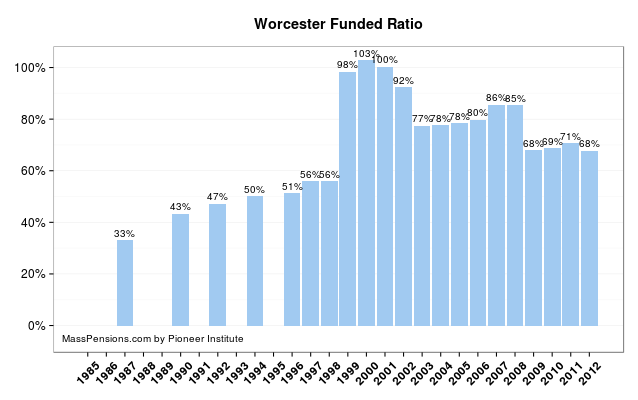City of Worcester has what is called a Defined Benefit Pension, which means employees work and receive a “defined benefit” based on their years of service and their salary. The City then needs to put aside money to make sure that they have the monies to pay these employees when they need their benefits.
Actuaries then look at 1) how much is put away and 2) how much will be paid out. If there is enough money put aside then the pension 100% funded. On the other hand, if there is not enough money put away it is “underfunded”. The Annual City Auditor report from last year shows the numbers on page 110. I like the funded number:
- 2008 – 85.58% funded
- 2009 – 67.98% funded
- 2010 – 68.80% funded
- 2011 – 70.70% funded
- 2012 – 67.74% funded
- 2013 – 63.74% funded
In other words at the end of the last fiscal year (graph does not include 2013), the City of Worcester has 63.74% of the monies that they need to have put aside to fund current pension obligations or we are 36.25% short.
What does the equate to in dollars and cents? The answer is staggering $410,448,000 million dollars. Then right after this there is a schedule called OPEB which stands for post employment benefits and we have another unfunded obligation of 636,335,000. Add these two together and the City of Worcester needs to come up with $1,046,783,000 or over one billion with a “B” dollars to pay off these obligations.
At least we are not as bad off as the Commonwealth of Massachusetts. According to the Beacon Hill Institute from February of 2013, the unfunded liability for Massachusetts three largest pension plans exceeds 23.6 billion dollars.
How do we stack up against other cities in the Commonwealth of Massachusetts. The Pioneer Institute gives us a “C”. Actually this report is great and very easy to read! Looking at these as a whole I can say this may be the next “bubble” to burst. In the end all these defined benefits pension plans will be changed to defined contribution plans (401 K).



